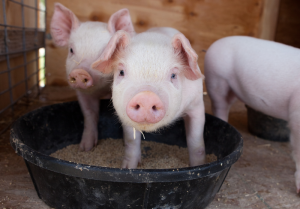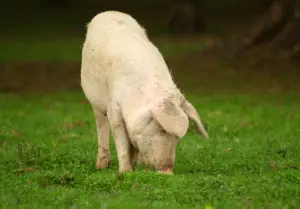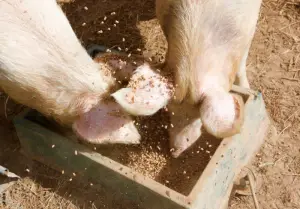Best Feed For Pigs
The right pig feed will enable your swine to reach their growth potential in a relatively short period of time. It will give your pigs everything they need to grow properly, and will ideally have the composition necessary for a flavorful, well-marbled meat. If you are raising pigs for meat, the bulk of their diet will need to consist of an optimally-formulated pig feed.
What is the best feed for pigs? While pigs can be raised on pasture and scraps alone, a swine-specific formulated feed will provide the nutrition necessary for a pig to grow properly and rapidly. Feeding commercial pellets that are high in protein, high in energy, and low in fiber is typically the most economical and efficient feed with which to raise pigs.
If you are raising a couple of pigs on a self-sustaining homestead, you can get away with a more natural feeding method. However if you are raising pigs for profitability, it would serve to understand how to economically raise healthy, strong animals in as little time possible. Read on to learn more about the best feed to provide your pigs.
Pig Feed According To Your Pig’s Age
As is the case with almost all other animals, a pig’s nutrition requirements will be different depending on its stage of life. You will not feed your 40-pound weaner the same way you will feed your 200-pound finishing hog.
What To Feed Weaning Pigs 
Piglets are voracious eaters, and will begin suckling from their mother almost immediately after farrowing. Piglets eat so much that though a good breeding sow will produce a high quantity of milk, she will not be able to meet her piglets’ nutritional demands after around 3-4 weeks. A piglet’s health can be kicked up a notch by introducing solid food before weaning.
“Creep feed” should be introduced when a piglet is around 15 days old. Creep feed is simply pig feed or grain that is introduced slowly in order to both prepare a piglet’s GI system for solid food and to increase calories and nutrition to improve the health and outcome of the piglet.
Whether your piglet is being introduced to creep feed or is entirely on solid food post-weaning, it is important to feed a higher protein feed to any young pig under 40 pounds. Pigs under 40 pounds should be fed a feed that is 18-21% protein.
What To Feed Growing And Finishing Pigs
A pig between 40 and 125 pounds is called a “growing” pig, as there is still significant and fast growth happening. A pig between 125 and market weight is called a “finishing” hog, as the animal is growing more slowly at this time and is being prepared for slaughter. Pigs are typically slaughtered when they reach between 250 and 300 pounds.
Growing and finishing pigs can both eat the same feed, and many feeds will be labeled and marketed as “grower-finisher” feeds. These formulas will have a slightly lower protein percentage, usually around 16%. Unless you are using a precision feeding model, most pig farmers free feed to ensure that all of their animals get the calories and nutrition they need.
Commercial Pig Feeds Vs. DIY Feed Mixes
Pigs are hardly picky, and can (and will) famously eat just about anything, including garbage. Pigs are naturally omnivorous, and are opportunistic eaters both in the wild and in captivity. For these reasons, creating your own feed mixture is not as difficult with pigs as it is with most other livestock and pets.
If you would like to create your own feed mix, you will want to do your research to determine the best combination of ingredients, how much of each ingredient to use, and to find popular and well-tested recipes. Every pig feed needs to be both high in carbohydrates and high in protein.
Corn is the most popular ingredient to achieve the necessary carbohydrates, and soybeans are the most popular way to incorporate adequate protein levels. Other popular ingredients include rice bran, broken rice, maize, cassava, and even distillery residue.
While it is not particularly challenging to create your own feed mix, purchasing a commercially available feed is the easiest way to ensure that your pig is getting everything required for fast growth, good health, and strong bones. If you are new to raising pigs, purchasing a formulated feed would be the recommended method. There are many brands of quality pig feed available, and the one you choose will most likely come down to what is available at your local feed store.
Can Pigs Survive On Pasture Alone? 
The question of whether pigs can survive and grow on pasture alone will depend on what is in your pasture. Pigs are omnivores, and require more protein for proper growth than other livestock. They will not thrive on grass alone. While pigs can certainly live on pasture, and are very happy to do so, they will need supplementation in the form of a pre-mixed feed or varied scraps.
If you would like your pigs to get the most dietary punch off of pasture, you will want to seed protein-rich grasses and legumes like alfalfa. Under proper pasture management, your pigs may be able to get 10-15% of their required calories and nutrition from pasture.
Of course, pigs have been domesticated for thousands of years, and our ancestors did not have neighborhood feed stores from which to purchase formulated feed. Pigs have historically been raised using more natural methods, with most of the diet of backyard pigs coming from forage (roots, grubs, acorns) and scraps (expired dairy products, stale breads, garden scraps, vegetable peels). This is not a “bad” way to raise your pigs, and is in fact a preferred method for the self-sufficient homestead. Nevertheless, it is a less efficient method by today’s standards.
As for feral hogs – yes, they do survive (and thrive) on forage and carrion. The difference here is that we aren’t concerned with the productivity of feral hogs – they don’t have nearly the growth potential or rate that a domesticated pig will have.
Pastured Pigs Require Management
What do we mean by pasture management? If you look at a pig’s snout, you will notice the anatomy and shape is quite distinct from other grass-eating livestock. Pig snouts are typically turned up, allowing them to “root”, and actually shovel, into the ground to dig for grubs, bugs, acorns, and roots.
After all, this is what feral pigs are eating in the wild – not grasses. While this makes the pig an effective hunter, the method of rooting is not kind to our pastures. A pig can quickly dig up a field and render the pasture useless if given the opportunity, all while creating divots and pits throughout the land.
All of this is especially hard on the pasture, and it will need time to recover. A properly managed pasture will be broken up into multiple “lots” – with at least three being ideal to meet the needs of a small herd of pigs.
This is called rotational grazing – when the pigs have turned up one field, you move (or rotate) them to the next. This allows the previous lot to rest, and then be re-seeded. By the time your herd is ready to rotate back to the original pasture, it will ideally be healthy and mature once again.
The Best Pig Feed Will Depend On Your Needs
Finding the best feed method for your pigs will depend on your individual operation. Feeding a small herd on a wooded lot will look a lot different than feeding a large herd on concrete. Likewise, you will need to determine what kind of meat you would like to produce – many claim that pasture-raised pork is tastier and healthier, though it is hard to argue the rapid growth potential of a confined herd. It is up to you whether the best feed for your operation will be pasture and scraps, formulated feed mixes, or a combination of both.
Feeding Pigs Is Big Business
Pork is the most consumed meat in the world, making pigs serious business. A significant amount of money and an astounding amount of time by scientists and universities have been spent on researching the most economical and efficient way to feed pigs, with the goal of producing as much high-quality meat in as little time as possible.
Efficiency is so consuming among the pig community that “precision feeding” has been introduced in many farms. These are highly individualized feed plans that have been shown to reduce production costs by 8%, reduce protein intake by 25%, and reduce greenhouse gasses by 6%, all while maximizing growth rate.
Pig feed has been endlessly studied, with new and practical breakthroughs being made every year. There are a lot of statistics surrounding the feeding of pigs, which can be both immensely helpful to the profit-seeking pig farmer, and also immensely overwhelming if you are trying to research the best way to feed your pigs. Here we will break it down for you in practical, simple jargon.

